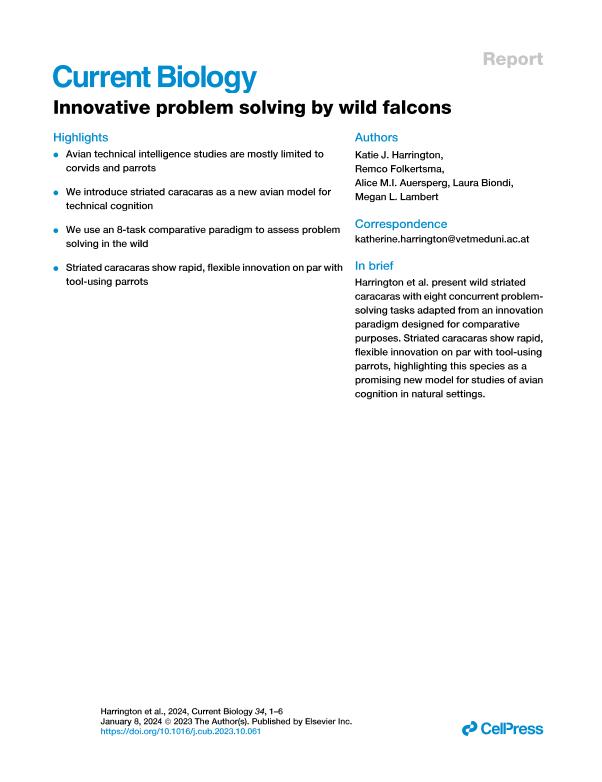Mostrar el registro sencillo del ítem
dc.contributor.author
Harrington, Katie J.
dc.contributor.author
Folkertsma, Remco
dc.contributor.author
Auersperg, Alice M. I.
dc.contributor.author
Biondi, Laura Marina

dc.contributor.author
Lambert, Megan L.
dc.date.available
2024-01-24T17:33:40Z
dc.date.issued
2024-01
dc.identifier.citation
Harrington, Katie J.; Folkertsma, Remco; Auersperg, Alice M. I.; Biondi, Laura Marina; Lambert, Megan L.; Innovative problem solving by wild falcons; Cell Press; Current Biology; 34; 1; 1-2024; 190-195
dc.identifier.issn
0960-9822
dc.identifier.uri
http://hdl.handle.net/11336/224748
dc.description.abstract
Innovation (i.e., a new solution to a familiar problem, or applying an existing behavior to a novel problem1,2) plays a fundamental role in species’ ecology and evolution. It can be a useful measure for cross-group comparisons of behavioral and cognitive flexibility and a proxy for general intelligence.3,4,5 Among birds, experimental studies of innovation (and cognition more generally) are largely from captive corvids and parrots,6,7,8,9,10,11,12 though we lack serious models for avian technical intelligence outside these taxa. Striated caracaras (Phalcoboenus australis) are Falconiformes, sister clade to parrots and passerines,13,14,15 and those endemic to the Falkland Islands (Malvinas) show curiosity and neophilia similar to notoriously neophilic kea parrots16,17 and face similar socio-ecological pressures to corvids and parrots.18,19 We tested wild striated caracaras as a new avian model for technical cognition and innovation using a field-applicable 8-task comparative paradigm (adapted from Rössler et al.20 and Auersperg et al.21). The setup allowed us to assess behavior, rate, and flexibility of problem solving over repeated exposure in a natural setting. Like other generalist species with low neophobia,21,22 we predicted caracaras to demonstrate a haptic approach to solving tasks, flexibly switching to new, unsolved problems and improving their performance over time. Striated caracaras performed comparably to tool-using parrots,20 nearly reaching ceiling levels of innovation in few trials, repeatedly and flexibly solving tasks, and rapidly learning. We attribute our findings to the birds’ ecology, including geographic restriction, resource unpredictability, and opportunistic generalism,23,24,25 and encourage future work investigating their cognitive abilities in the wild.
dc.format
application/pdf
dc.language.iso
eng
dc.publisher
Cell Press

dc.rights
info:eu-repo/semantics/openAccess
dc.rights.uri
https://creativecommons.org/licenses/by/2.5/ar/
dc.subject
BEHAVIORAL FLEXIBILITY
dc.subject
COGNITION
dc.subject
EXPLORATION
dc.subject
INNOVATION
dc.subject
NEOPHOBIA
dc.subject
PHALCOBOENUS AUSTRALIS
dc.subject
STRIATED CARACARA
dc.subject.classification
Zoología, Ornitología, Entomología, Etología

dc.subject.classification
Ciencias Biológicas

dc.subject.classification
CIENCIAS NATURALES Y EXACTAS

dc.title
Innovative problem solving by wild falcons
dc.type
info:eu-repo/semantics/article
dc.type
info:ar-repo/semantics/artículo
dc.type
info:eu-repo/semantics/publishedVersion
dc.date.updated
2023-12-22T15:37:57Z
dc.journal.volume
34
dc.journal.number
1
dc.journal.pagination
190-195
dc.journal.pais
Estados Unidos

dc.description.fil
Fil: Harrington, Katie J.. Medical University Of Vienna; Austria
dc.description.fil
Fil: Folkertsma, Remco. Medical University Of Vienna; Austria
dc.description.fil
Fil: Auersperg, Alice M. I.. Medical University Of Vienna; Austria
dc.description.fil
Fil: Biondi, Laura Marina. Consejo Nacional de Investigaciones Científicas y Técnicas. Centro Científico Tecnológico Conicet - Mar del Plata. Instituto de Investigaciones Marinas y Costeras. Universidad Nacional de Mar del Plata. Facultad de Ciencias Exactas y Naturales. Instituto de Investigaciones Marinas y Costeras; Argentina
dc.description.fil
Fil: Lambert, Megan L.. Medical University Of Vienna; Austria
dc.journal.title
Current Biology

dc.relation.alternativeid
info:eu-repo/semantics/altIdentifier/url/https://linkinghub.elsevier.com/retrieve/pii/S0960982223014628
dc.relation.alternativeid
info:eu-repo/semantics/altIdentifier/doi/http://dx.doi.org/10.1016/j.cub.2023.10.061
Archivos asociados
